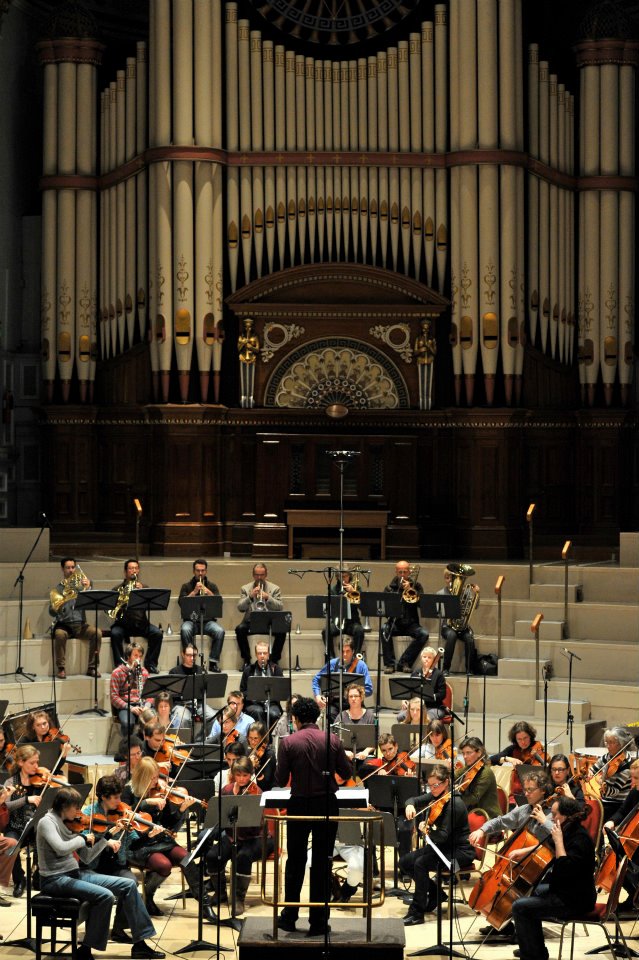There are two and a half days left to listen to the current episode of Hear and Now, which includes one of the five pieces performed on the November 20th Basel Sinfonietta concert at the Huddersfield festival called from Scratch. Three more of the pieces will be broadcast on Saturday, and the entire Basel performance of the same program (works by Michael Parsons, Christian Wolff, Jürg Frey, James Saunders, and Tim Parkinson) will be on this broadcast on December 28th. (Mark your calendars—I’m not at all sure that that broadcast will be available after the fact.)
Breaking up the orchestra according to its most obvious groups (winds, strings, brass…) might seem like naïve orchestration. It probably would be if it were done badly. But Tim Parkinson has a strange and wonderful ability to find his material within the most basic of premises. It is a conscious, committed, and uncompromising approach that he has been engaged with for years. In a 2003 interview now published in The Ashgate Research Companion to Experimental Music, he spoke about another piece:
What’s been interesting for me during the working process is that I’ve just come back to the … structure again, but my arrival at that decision was as if I’d never done it before, as if I’d just come up with the idea for the first time, like a surprising revelation…. I start afresh every time and I seem to work very close to the page, then step back and see what’s emerged.
In reference to orchestra piece (yes, that’s the title), he said on the radio broadcast:
…I wrote it for the idea of an orchestra, really. I mean, my history has been mostly in chamber music and solo music. But one way of thinking of an orchestra is, it’s all the instruments, in a way. Writing a piece for all of the instruments. So for example, the opening of the piece, this very large sort of woodwind block of sound that was conceived exactly for that, for 10 independent wind players. Orchestral music doesn’t necessarily have to be big blocks of sound all the time or something. It can also be two oboes or solo violin or something. So this all informs this idea of what is orchestra.
Instrumental groups (strings, winds, brass) almost always play together, dynamics are all set at mid range, and there is little to no phrasing or vibrato. (An analogy comes to mind: of situations in which people are unexpectedly thrown together and start to interact. The circumstance drives them to acknowledge and better understand their common, basic humanity.) In Parkinson’s hands, this set of limitations doesn’t just lead away from any traditional type of orchestral sound. It leads towards a new vibrancy. Like in a Mondrian painting, one color does not blend with another, but offsets it. Those blocks are broken into smaller, but still definable, parts in a hocketing section between the groups. The open wind section that he mentions does separate the players in an active counterpoint, which leads to an extreme “windness” of the collective sound that is more than the sum of its parts. When the strings come in, they all follow the same contour of upward arpeggiation, part of a type of motion which later maps onto the whole orchestra near the end of the piece. When the orchestra plays together (for example in nearly 30 great seconds of quarter note middle C’s and the opening out of pitch that follows), it has a new composite color. The orchestral groups have combined into one, but there is still no shading.
 [photo credit: Brian Slater. Follow the link on the image for more.]
[photo credit: Brian Slater. Follow the link on the image for more.]
In the 2003 interview referenced earlier, Parkinson points out some of the common material that composers use. “I don’t incorporate found material at all, except in so far as I feel that all the notes available to use are the same notes and intervals that any other composer has ever used. So I have at the start a certain objectivity in working with what I present myself with.” In this instance it’s the same orchestra, in the most basic sense, that any other composer has ever used. There are countless points of decision in the act of writing an orchestral piece. Parkinson took a good look around at the outset and decided to orchestrate based on the fundamental properties of the orchestra. That decision turned out to be in keeping with the legacy of the Scratch Orchestra referenced in this set of concerts.
Manuel Nawri‘s conducting was as faithful to the extreme compression of techniques found in orchestra piece as it was to the numerous other, very different requirements he encountered in the works on ELISION’S transference CD. And the freshness and vibrancy of the orchestral sound is a credit, not only to Parkinson’s writing and Nawri’s conducting, but to the players of the Basel Sinfonietta.
The broadcast also includes works by Christian Marclay, James Dillon, and Morton Feldman. You can hear it here until Saturday evening. The discussion of Parkinson’s piece more or less begins at 18:14, and the performance starts at 19:54.
